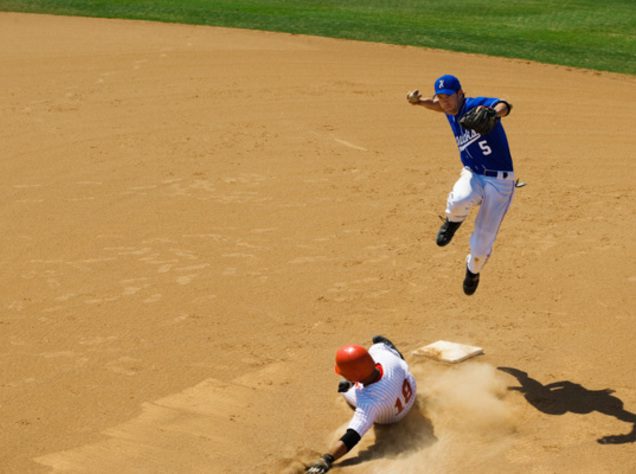Executing The Double Play
On a very base level, baseball is typically one of our most slow-moving sports. Players aren’t running at aggressive speeds, slamming into each other while carefully maneuvering about the field; even the triple-digit fastballs are meticulously placed and positioned. For the most part, baseball is an incredibly methodical sport, so those rigid and quick-thinking moments should be so wonderfully enjoyed. To many, the execution of a double play can be one of baseball’s most beautiful moments — the creativity, fluidity, and spectacular nature of each opportunity can be breathtaking.
Double plays, of course, happen over all types of scenarios, but there are a few constants that any infielder must have: speed, accuracy, and intelligence. Whether it’s a game-saving play in the ninth or an inning-ending jam in the fourth, a smooth double play can energize a team. So, if you’re positioned in the infield, you’d be wise to consider these ace tips from CoachUp, that way, you can start zipping the ball around the dirt like a true professional.
Staying Sharp
One particular thing that many youth players struggle with during the double play happens before there’s even any physical contact. It’s imperative that you’re well-aware of the game’s situation, score, and preferred decision if the ball comes your way. If you’re a shortstop and there’s a runner on first, second, and third — you must be asking yourself questions before the pitch. Where are the force outs?
What will end the inning? Is stopping the run at home more important than the double play? What’s the score? In some situations, despite common sense, the preferred solution for any given position may change on-the-fly — if you’re winning by just a run and a double play doesn’t end the inning, perhaps your play is to home, not second, right? But if the score is 9-1 in your favor, bases loaded, with no outs — your coach will most likely trade two outs, effectively killing any mounting rally, for a run that won’t matter in the long run. Be smart, be on your toes, and know where you’re going before the ball comes your way! It’s the simple hesitation and moment’s thought that often ruins any chance at saving a run, stopping a rally, or successfully completing the double play.
Staying Clean
Believe it or not, this is where most people slip up — that’s right! Just like you can mishit a soccer ball or drop a pass from the quarterback, the same can go down in baseball as well. Simply put, don’t focus on the end result before effectively beginning the motion! Players have a tendency to line up the grounder and start throwing it before they’ve even completely secured it. When that happens, you run the risk of not only ruining the double play, but any following errors could result in advancing runners as well. It’s natural to mistakenly take your eyes off the ball, the frantic circumstances often demand it, but you must not get ahead of yourself! Stay down in a defensive stance, watch the ball into your glove, and begin your natural motion towards second. For extra information on cleanly fielding grounders, head over here!
Quick Release
Now that you’ve got the ball and know where you’re going with it, what’s next? Of course, this depends on your position and location, but a quick-release throw or toss is typically the poison of choice. For third baseman, their throw is crucial, it must be fast enough to travel to second and then first before the runner gets there, but it also must be deadly accurate all the way through. Even a slightly-off throw from third will end up in the outfield if it’s not carefully calculated. For those playing second base or shortstop, they can typically do well with an underhand flip to their teammate, that way, it will be accurate, quick, and deadly.
On the rare occasion that the first baseman initiates the double play, he will often step on first initially before throwing to second. Of course, once the runner is out at first, he’s no longer forced to second base, meaning that the throw must be nearly perfect in order for the shortstop to not only receive the pass, but also tag the oncoming runner. In all these scenarios, particularly in ones with fast baserunners like Cincinnati’s Billy Hamilton or Miami’s Dee Gordon, the faster your release, the better.
The One-Handed Bandit
For those middle-infielders, they’ll often opt to forgo the glove entirely in order to get the ball to its next location quicker. Atlanta’s Andrelton Simmons, hailed as one of the MLB’s best defensive players currently in the league, has made a living off of ditching the glove and in double play scenarios, it could be the difference between the game-tying run and clinching the win. Grabbing the ball off the flip or short toss can cut down on throw time to the all-important force out at first — but be careful, this can hurt if you decide to go for the wrong one!
Pro-Tip: Watch out for those pesky baserunners! In order to breakup your double play attempt, baserunners will often alter their sliding motion so they can distract, create contact, or force an error from the fielders. Thanks to this, the best fielders will either try to release the ball before the baserunner reaches them, or they’ll sidestep out of the way before throwing. However, this one extra step or hesitation could very well lead to safe baserunners!
The Force
Now that you’ve got all these incredible tips for nailing that double play, it’s time to take a tiny step back. If you’re watching highlight reels, you’re unlikely to see anything but diving plays, fancy flips, and impressive force outs — however, there is one additional skill that all the best fielders possess: intelligence. Sometimes, if there’s an error, bobble, or slow transfer from glove to hand, the infielder will rush the throw and hurt their team further. Don’t compound your error with another! Don’t throw it into the stands because you’re too laser focused on the baserunner! Ultimately, it’s just as important to know when to let things go, hold onto the ball, and live to field another day.
(Related: Read about being an effective first baseman here.)
Huddle Up
As you can see, there’s plenty to keep in mind before, during, and even after the attempt at a double play. Where are you going? Where are they going? Should I barehand it? Should I throw it at all? All of those questions, and more, must be asked before every pitch, toss, or force out. Remember, your physical abilities will only get you so far in your infield efforts, but it’s your mental preparation and decision-making that will truly help you shine in that infield dirt. However, if you’re still struggling with any facet of the double play, consider booking one of CoachUp’s private coaches in order to help you out. Our wonderful team will have you playing at full confidence with a new arsenal of skills in no time — what are you waiting for?
How useful was this post?
Click on a star to rate it!
Average rating 0 / 5. Vote count: 0
No votes so far! Be the first to rate this post.



